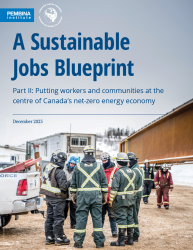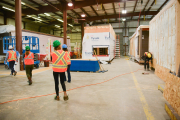Canada needs a jobs plan. At this critical time in history, we need a vision for the future of the workforce that is clearly aligned with the country’s economic priorities, including the transition to a low-carbon economy. A jobs plan would provide provinces and territories, labour, employers, and training institutions with a clear strategy and direction to coordinate and align their efforts in tackling the many societal challenges we presently face: labour shortages, housing crisis, and affordability challenges.
The Pembina Institute participated in the consultation exercise conducted by Employment and Social Development Canada’s engagement on fostering a modern, inclusive, and productive labour market for the 21st century. Earlier this month, we shared our recommendations with ESDC and published the accompanying letter to Minister Boissonnault on our website.
Last week, I had the opportunity to share our messages in person at the ESDC Workforce Summit in Montreal.
The meeting brought together diverse perspectives, including business, labour, education and civil society, to explore ways that Canada can:
- align workforce strategies with economic priorities
- eliminate inefficiencies and barriers in the labour market
- maximize labour productivity through skill development and lifelong learning
Common solutions are arising from this diverse group.
There is a need for job plans that begin to define the types of job and related skills to power our changing economy. In the energy transition, there will be changes that eliminate or change existing jobs while introducing new ones. There will be jobs that remain similar, producing new products using existing processes. And there will be brand new jobs resulting for changes in technology and process. This variation means jobs plans are needed that specifically address sectoral and regional requirements and consider both near-term and future labour requirements.
For a jobs plan to succeed, Canada needs a comprehensive labour market analysis and model future economic scenarios to identify the impact of demographic shifts, automation, and the global energy transition. We also need to look at other megatrends such as digitization, AI, and the coming retirement boom. Reliable, accessible and relevant data can inform workforce development planning and investments.
We encourage Canada to continue to invest in and implement policies and programs that support education and training institutions and employers with resources to train workers, provide financial supports for workers seeking assistance — particularly for equity-deserving individuals — and to support youth and workers at all stages of their careers in navigating career prospects.

According to modelling undertaken for the Pembina Institute’s Sustainable Jobs Blueprint reports, we could see net growth of 700,000 jobs in a low-carbon economy – primarily in net-zero buildings and transportation sectors – by 2050. We have found that job growth in clean economy sectors offset potential job losses in the traditional energy sector (oil and gas).
Data driven jobs plans and consistent investment in one of Canada’s greatest assets – it high quality workforce – can be expected to put people in the right jobs, enabling our economy and supporting our communities.








